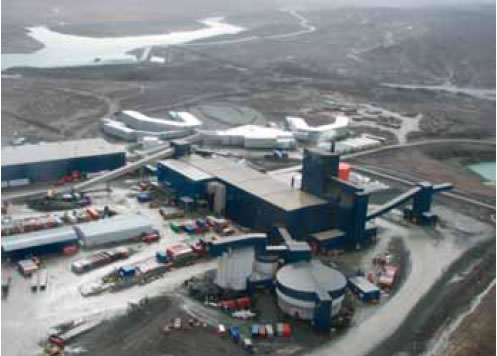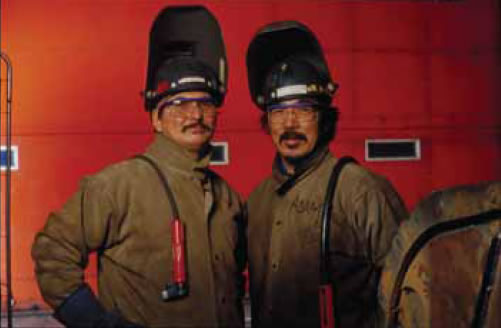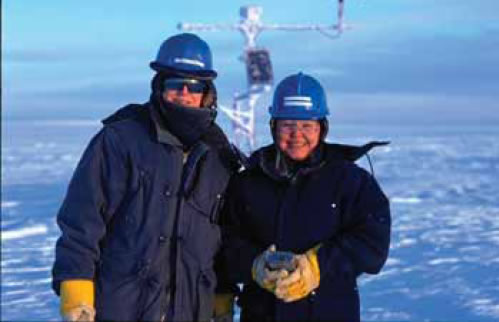Raglan Mine - Quebec
PDF version (204 kb)
Partnership Agreements
The Lands and Minerals Sector of Natural Resources Canada promotes the participation of Aboriginal communities in minerals and metals activities across Canada by sharing information on Aboriginal-industry leading practices.
Project
The Raglan mine sits upon one of the world's finest sulphide nickel deposits in the vast Ungava Peninsula, in Nunavik, some 1800 km north of Montréal. The mine began production in 1997 after more than 30 years of exploration, negotiation, and development. In August 2006, Xstrata PLC acquired ownership of Falconbridge Limited and has been operating the Raglan mine under the Xstrata Nickel business unit since that time. Today, the nickel and copper-producing facility operates three underground mines and one open-pit mine. Once crushed and treated, ore is trucked 100 km to the port of Deception Bay where it is transported by sea for smelting (in Sudbury, Ontario) and refining (in Nikkelverk, Norway). Roads are scarce in Nunavik, with the nearest Inuit villages of Salluit and Kangiqsujuaq accessible only by air from the mine site. The current mine life is estimated at more than 30 years.

Signed Agreements
In 1995, the Raglan Agreement was signed between the mine operator, the Qaqqalik Landholding Corporation of Salluit, the Salluit community, the Nunaturlik Landholding Corporation of Kangiqsujuaq, the Kangiqsujuaq community, and Makivik Corporation, which oversees the political, social, and economic development of Nunavik. The agreement includes profit-sharing measures and trust fund payments over an 18-year period, with the mine making a payment to Makivik Corporation of $9.3 million in 2006 and $16.7 million in 2007. The agreement also guarantees preferential hiring and contracting to local, qualified Inuit employees and businesses. The Raglan Committee meets several times each year to discuss environmental concerns and to report on the progress of the agreement. Inuit representatives from Salluit, Kangiqsujuaq, and Makivik Corporation occupy half of the committee's six seats with mining company officials holding the balance.
Employment and Training
Currently, the Raglan mine employs more than 600 workers at the mine site. Of this number, 96 are Inuit. Employees are flown in from surrounding communities for two-week shifts, followed by two weeks off, and are housed in a 400-room, hotel-style complex. The facility contributes to further employment by contracting to a number of Inuit-owned companies and joint ventures that provide goods and services to the mine. Overall, the Inuit employment rate at Raglan is about 16%. Training programs aim to provide further opportunities. The Raglan Employment and Technical Training Committee (RETTC) has developed an aggressive Inuit training plan in an attempt to employ Inuit workers at all skill levels and increase the Inuit representation to over 20%. Raglan's Inuit employment and training officers cooperate with local agencies to find job candidates for the training program. Raglan has organized awareness activities in all 14 of Nunavik's high schools to discuss with students future mining-related jobs and careers at the mine. Furthermore, to reinforce this initiative, the Raglan Education Fund provides scholarships for post-secondary studies in mining-related fields.

Economic/Business Development
Since the beginning of its expansion process four years ago, the Raglan mine is proud to note that its sustainable development strategy, as mentioned in the Raglan Agreement (1995), has concretely materialized in terms of the mine's contribution to the Nunavik economy and its communities. In fact, not only has the annual profit-sharing program increased since 2004 for its Inuit stakeholders, but the mine's Inuit business partners (contractors and joint ventures) have also seen their accrued interests double since they were awarded contracts from Raglan. The mine's direct contribution to Nunavik's economy is forecast to be $130 million by the end of 2007; this includes profit sharing with stakeholders, employees' salary earnings, and business contracts with Inuit companies and joint ventures.
Social/Cultural and Community Support
In an attempt to ease the strain of separation from families and isolation at the mine site, Inuit workers are flown to their home communities at the end of each two-week shift. Cross-cultural training programs, career counseling, and employee assistance programs are designed to address the current and future needs of Inuit and non-Inuit employees. Access to a freezer and kitchen facilities for storing and preparing country food is available to Inuit employees.
Environmental Protection
After extensive baseline studies, the Raglan project was designed to minimize water effluent, water consumption, and air emissions while containing acid mine rock and providing for the progressive reclamation of tailings. The six-member Raglan Committee, with 50% Inuit representation, meets several times each year to discuss mine-related environmental issues. In order to protect the fragile sub-Arctic permafrost, the workers' residence stands 40 feet above the ground on steel pile foundations.
Also, in collaboration with the two neighbouring Inuit communities, Raglan conducted an Arctic char monitoring program by integrating their traditional knowledge into a Joint Scientific Fishing Program. In fact, traditional Inuit knowledge of the environment was also a factor in environmental impact assessments prior to mine operation, with local knowledge of Arctic chars and of marine mammal migration patterns (e.g., for seals) resulting in Raglan's decision to shorten the shipping season and avoid ice breaking from March to June in Deception Bay.
Moving Forward
The Raglan mine entered a new phase in 2006 with a change in ownership. The new owner, Xstrata Nickel, is now developing new strategies to better define the important reserves already in place in order to support a new expansion phase planned for the next few years. The project would create several additional jobs and increase the economic benefits for the entire Nunavik Territory via their numerous Inuit stakeholders.

For more information on the Raglan mine, please visit the Glencore Mine Raglan website or contact the company by telephone at 819-762-7800 or by fax at 819-797-0531.
Photos courtesy of Xstrata PLC (used with permission).
2007
For more information on Aboriginal communities and mining, visit the mining and materials web site or contact us.
Page details
- Date modified: